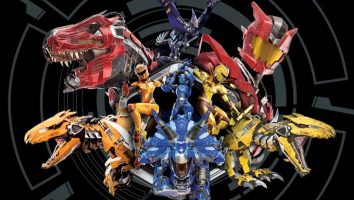One of the stranger moments when Jeff ‘Swampy’ Marsh (The Simpsons), co-creator of the popular Disney animated series Phineas and Ferb, realized the show had become something bigger than he and co-creator Dan Povenmire (Family Guy) could ever imagine was when they witnessed Wayne Newton singing the Perry the Platypus theme song with about 25 Vegas dancers in Perry-themed outfits during Licensing Show 2010 in Vegas. “I looked at Dan and said, ‘This is just the weirdest thing ever.'” Weird or not, there’s no denying the global success of the Phineas and Ferb brand.
Since making its broadcast debut in 2008, the Disney Channel and Disney XD comedy series for kids ages four to 15 is now entering mega-franchise territory spawning three additional top-rated seasons, more than 289 million viewers worldwide from kids to adults, celebrity guest stars including David Beckham, Simon Pegg and Selena Gomez, apps, video games, social media extensions, books, music, magazines, consumer products, a live-action spin-off talk show, a live stage show, a hit Disney Channel original movie, and an upcoming Marvel cross-over special.
In the lead-up to his upcoming master class presentation at this year’s Children’s Media Conference in Sheffield, England next week, Marsh took some time to chat with Kidscreen about the success of the series, its influence on newer animated Disney fare, and how he forced his friends to change his nickname.
Why has Phineas and Ferb resonated so much with kids and adults?
From all the feedback we’ve received from parents, adults who don’t have kids, college students and little kids, we found they all love the show because it is smart and treats children as intelligent beings. It was our attempt to bring back family viewing. We took it as a challenge to see if we could create a show that was fun, edgy and connected to everybody in the family, yet still be a nice, sweet show that wasn’t based on a collection of jerks and idiots. Once we made the decision to go that route we realized finding the humor was more difficult, but infinitely more rewarding.
How are your adult sensibilities for comedy translated into the show?
Dan and I both met on The Simpsons, but I went on to King of the Hill and Dan went to Family Guy. All of our writing (on Phineas and Ferb) has that same kind of delivery you get with The Simpsons. It’s not a wacky cartoon delivery. It’s much more naturalistic and realistic. It always makes the show feel funnier especially when you look at the crazy things Phineas and Ferb and Dr. Doofenshmirtz are doing.
What were some of the bigger challenges in creating the show?
One was getting people to buy into the notion of not talking down to kids and overcoming any disbelief over whether our target audience would get the jokes. We said we don’t really care as long as a joke doesn’t cause them to change the channel. It’s okay to aim some of the jokes at parents because the worst thing that can happen is the parents will laugh and the kid will ask, ‘Why are you laughing?’ And then that begins a conversation. It was a tough concept in the beginning.
Another challenge was making the show how we wanted to make it, which was without scripts. This takes a huge amount of faith and courage from the broadcaster. If you met us or spent any time with us you really wouldn’t trust us that much with a giant budget. We don’t have a solid story until we’re about six weeks into the process so that’s a lot of water under the bridge until the broadcaster gets to see what we’re producing. But it creates a show that feels more spontaneous and more visually-driven than you could ever get out of scripts.
Has the series influenced newer Disney animated kids shows?
When we were developing the show we were told it wasn’t really a Disney show. Some people said they loved it, but it probably wouldn’t make it to air. Dan and I thought how cool it would be if the show changed the demo of the Disney Channel and Disney XD and had a noticeable impact on the type of shows they create and the type of talent they attract. When we started to see the new wave of shows and styles being developed after our show it was hugely rewarding because the level of creative people Disney TV animation was attracting had clearly changed. I don’t think you could have a show like Gravity Falls on the network if it hadn’t been for the fact that Phineas and Ferb was embraced and accepted so quickly by the audience. When we came on Disney was also mostly a channel for girls, but Phineas and Ferb was successful almost right down the middle between boys and girls.
How did you get your nickname?
When I was living in Exeter, England in 1980 people started jokingly calling me ‘boggy’ Marsh or ‘swampy’ Marsh. Then I found out bog was slang for ‘washroom’ and I threw a fit. I raised such a fuss that they all started calling me ‘Swampy’ very pointedly. It wasn’t a great name to have when I was a computer executive, but once I got into animation it was a positive boon.
Jeff ‘Swampy’ Marsh will be giving this year’s Creative Keynote at The Children’s Media Conference in Sheffield from July 3-5. To register for the conference or find out more, head over to www.thechildrensmediaconference.com.
























